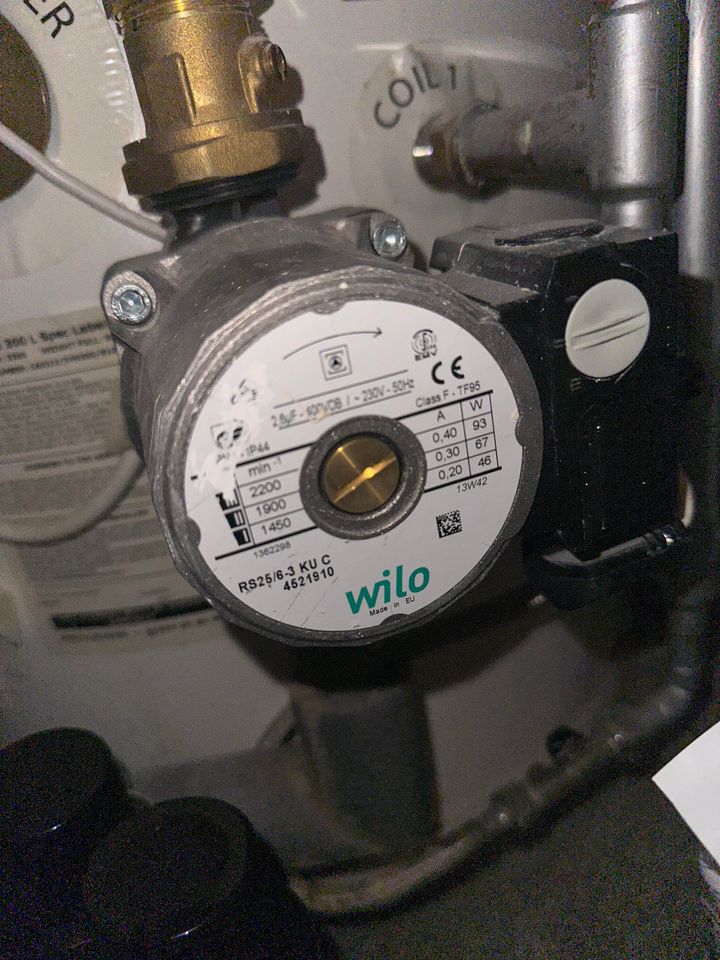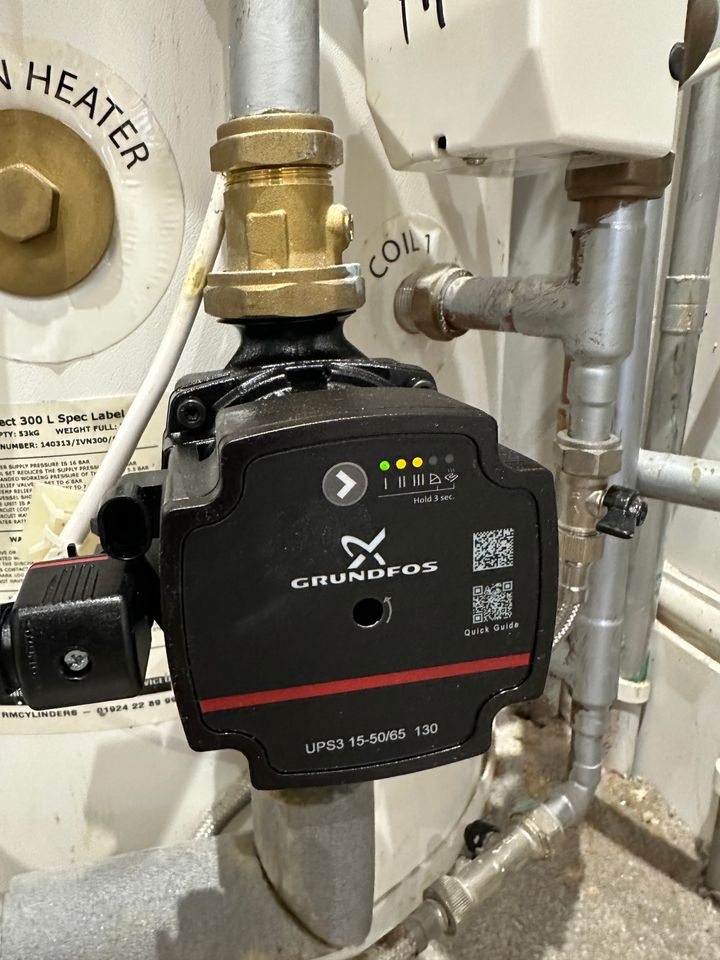Central heating pump replacement
Discussion
Hi all,
My CH pump has been playing up over the last few weeks and I think it has been seizing overnight as it needs to be hit with a screwdriver head some mornings to get it going. I have bled it, and it doesn't seem to have any air in it, but is noisy nonetheless (and more noisy now than it has been in the past).
The current pump is a Wiko RS25/6-3 which I suspect is around 9 years old. I'd like to replace it with something which is a straightforward replacement, but not really sure where to start. There seems to be a huge range of pumps from sub-£100 to close to £1k. I don't mind spending a bit more money on something that is more efficient and will last a while, but also want it to be relatively easy to fit - I.e. to not have to mess about shortening/lengthening pipework. I do have valves above and below the pump which is a bonus.
My questions are:
- Are CH pumps generally a universal fit? Or should I be sticking to the same brand.
- What spec do I need to pay attention to? The house has about 13 radiators / 2 floors and is well insulated.
- Are there any features that are worth having? Most seem to have different speeds, some seem to have error reporting such as airlocks.
Thank you in advance!
Nick

My CH pump has been playing up over the last few weeks and I think it has been seizing overnight as it needs to be hit with a screwdriver head some mornings to get it going. I have bled it, and it doesn't seem to have any air in it, but is noisy nonetheless (and more noisy now than it has been in the past).
The current pump is a Wiko RS25/6-3 which I suspect is around 9 years old. I'd like to replace it with something which is a straightforward replacement, but not really sure where to start. There seems to be a huge range of pumps from sub-£100 to close to £1k. I don't mind spending a bit more money on something that is more efficient and will last a while, but also want it to be relatively easy to fit - I.e. to not have to mess about shortening/lengthening pipework. I do have valves above and below the pump which is a bonus.
My questions are:
- Are CH pumps generally a universal fit? Or should I be sticking to the same brand.
- What spec do I need to pay attention to? The house has about 13 radiators / 2 floors and is well insulated.
- Are there any features that are worth having? Most seem to have different speeds, some seem to have error reporting such as airlocks.
Thank you in advance!
Nick
Do you have isolator valves either side of the pump housing? If so, it's an easy replacement - go on eBay and buy the same pump, turn off the system and isolate the power, close the valves either side of the pump, take a photo of the wiring and then unwire the pump from within the control box on the side (three wires), unscrew the pump from it's housing (ie the four Allen bolts around the pump motor (have towels /bucket prepared to catch the water in the pump body), put in new pump motor, wire up etc etc reversing the steps above.
Then you'll just need to top up the system at the filling loop and bleed the rads to get rid of the air you introduced.
Then you'll just need to top up the system at the filling loop and bleed the rads to get rid of the air you introduced.
I replaced a grundfoss like for like a couple of years after moving into my house.
One half of the rads weren't hot (can't recall if up or downstairs).
It had isolators either side luckily , but I mangled the 52mm nuts with my stillson (since bought the correct spanner for a few quid).
What I found: sludge. Lots of it, which had gummed it all up.
So I subsequently flushed the system, fitted a magnet filter, cut out and replaced some blocked pipes and kept on top of inhibitor.
(I flush it by removing the water pump hence why buying the spanner made sense)
Hth
One half of the rads weren't hot (can't recall if up or downstairs).
It had isolators either side luckily , but I mangled the 52mm nuts with my stillson (since bought the correct spanner for a few quid).
What I found: sludge. Lots of it, which had gummed it all up.
So I subsequently flushed the system, fitted a magnet filter, cut out and replaced some blocked pipes and kept on top of inhibitor.
(I flush it by removing the water pump hence why buying the spanner made sense)
Hth
I thought they’d stopped selling ‘basic’ pumps like that and they had to be electronic now? In our old system the pump used to go every few years and replacements went from being £30 or so to £100 for the electronic ones.
Last one before boiler was replaced was a Wilo Yonos from Screwfix for £100 ish. Didn’t like being on variable speed sp just set it for fixed speed 2. I think the only critical thing is the overall length - distance between flange mounting faces and for domestic circulators they’re pretty well standard size.
Last one before boiler was replaced was a Wilo Yonos from Screwfix for £100 ish. Didn’t like being on variable speed sp just set it for fixed speed 2. I think the only critical thing is the overall length - distance between flange mounting faces and for domestic circulators they’re pretty well standard size.
Be prepared for every nut to be seized and for the isolation valves not to isolate 
Mine looked way older than yours, so I planned for failure, new pump, two new valves, new rubber seals, swear jar emptied
The first of the 2 nuts is usually a lot easier than the second as the whole lot is seized solid. Once the first nut is loose this is no longer the case.
I ended up removing one of the valves with the pump as there was no way the valve to pump nut was undoing in-situ.
I'm pretty sure all domestic pumps that look like that are the same size, but if replacing the isolation valves, check their sizes!
You can get pumps with variable speeds, so they slow down when the back pressure increases as the trvs close, reducing noise.
I got a grundfos ups3 new from ebay for about half the screwfix price, there seems a lot of new plumbing bits on ebay, almost like the plumbers are selling surplus bits that customers have paid for

Mine looked way older than yours, so I planned for failure, new pump, two new valves, new rubber seals, swear jar emptied

The first of the 2 nuts is usually a lot easier than the second as the whole lot is seized solid. Once the first nut is loose this is no longer the case.
I ended up removing one of the valves with the pump as there was no way the valve to pump nut was undoing in-situ.
I'm pretty sure all domestic pumps that look like that are the same size, but if replacing the isolation valves, check their sizes!
You can get pumps with variable speeds, so they slow down when the back pressure increases as the trvs close, reducing noise.
I got a grundfos ups3 new from ebay for about half the screwfix price, there seems a lot of new plumbing bits on ebay, almost like the plumbers are selling surplus bits that customers have paid for

Thank you all for your words of wisdom (and apologies for seemingly ignoring most of them). I’ve somehow managed to luck myself through successfully changing it.
The valves were quite crusty, but did the job and don’t appear to be leaking. I ended up going for a Grundfos UPS3 which seems to be a favourite on YouTube at least- but importantly was available at Screwfix this morning. This new pump has variable speeds which is great as it’s now silent, and hopefully cheaper to run.
Was easy to change brands- but did mean I had to rewire the pump plug (5 min job). The new pump came with rubber washers which has stopped a previous weep (the previous one were completely perished).
30 mins all in, but would have been quicker if I wasn’t bracing myself for failure at every stage! I can see how it can go very wrong if the valves fail, but this was pretty much plug and play.
ETA: For those familiar with the Grundfos settings, I was running it max mode here to push and air bubbles out, but have moved it to the variable mode now.

The valves were quite crusty, but did the job and don’t appear to be leaking. I ended up going for a Grundfos UPS3 which seems to be a favourite on YouTube at least- but importantly was available at Screwfix this morning. This new pump has variable speeds which is great as it’s now silent, and hopefully cheaper to run.
Was easy to change brands- but did mean I had to rewire the pump plug (5 min job). The new pump came with rubber washers which has stopped a previous weep (the previous one were completely perished).
30 mins all in, but would have been quicker if I wasn’t bracing myself for failure at every stage! I can see how it can go very wrong if the valves fail, but this was pretty much plug and play.
ETA: For those familiar with the Grundfos settings, I was running it max mode here to push and air bubbles out, but have moved it to the variable mode now.
Gassing Station | Homes, Gardens and DIY | Top of Page | What's New | My Stuff



